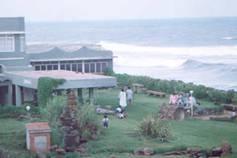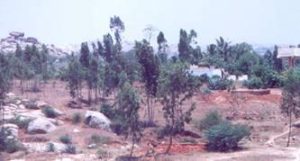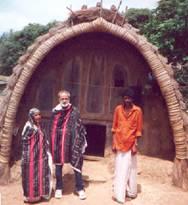
Lost in India – 9. ASHRAM TO OOTY
9. ASHRAM TO OOTY (March 27 – April 4, 2000)
It was just after five in the evening when I arrived at the bus station in the southwest of Pondicherry. It is easy to find places here because roads are laid on a grid plan just like towns in North America.
A strong evening breeze drove fairly big waves against rocks lining the shore. I could not resist going out again. I walked the entire length of Beach Road. On the broad walkway evening crowd of local people was soaking in the breeze from the Bay of Bengal. I dined at the in-house vegetarian restaurant run by a very pleasant Gujarati.
After checking-out early next morning, I walked to Aurobindo Ashram. In the courtyard are two samadhis (tombs). One is of Aurobindo, a
It was quite hot and I was feeling languid. So I decided to walk the one and a half kilometre to Park Guesthouse located at the south-eastern end of the town, right on the seashore. Sri Aurobindo Ashram runs this guesthouse mainly for visiting devotees. Fortunately the Ashram was not having any meeting and I was offered an excellent large clean room with private bath and a spacious balcony overlooking a well-manicured garden and a heavenly view of the sea. A strong evening breeze drove fairly big waves against rocks lining the shore. I could not resist going out again. I walked the entire length of Beach Road. On the broad walkway evening crowd of local people was soaking in the breeze from the Bay of Bengal. I dined at the in-house vegetarian restaurant run by a very pleasant Gujarati.
After checking-out early next morning, I walked to Aurobindo Ashram. In the courtyard are two samadhis (tombs). One is of Aurobindo, a venerated sage of modern times and the other of his successor The Mother. In his erudite prolific writing, Aurobindo has synthesized yoga and science. At one time he became very popular among westerners. In the yard a dozen people meditated in perfect silence.

What is left of the Pondi Temple
One sad looking young man sat embracing the tomb itself with his head placed on the cold stone as if he had his ear plugged in and recording the sage’s spiritual message emanating from inside. At the back, I noticed an old black Humber car. If restored it should have considerable antiquity value.
The nine o’clock bus took three hours to reach outer Chennai and another hour to the station. The rest of the day I visited the city. First I walked to Fort St. George and its Museum. The atmosphere here does not appear to have changed since the British East India Company built the fort in 1653. I felt taken back in time. Probably it was nicer then. The porches of the dilapidated outer wall house small craftsmen and workers. Being a tourist attraction some attempt should have been made to keep this area clean and less smelly.
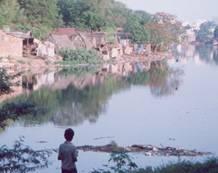
Kuvam River, Chennai
Tracing my steps back I decided to see the Kuvam (Cooum) River, which on the map seemed to be city’s main beauty attraction. Langs Garden Road is filthy, but the river is filthier. Ignore the slums on the other bank, do not see what is floating in the placid river and do not breathe through the nose, the scene is beautiful. I spent considerable time in bookshops in Anna Salai and walked back to Hotel Pandian tired and hungry.
On Friday 31 March I boarded the 7.15 a.m. train to Bangalore. It was a pleasant journey. On the plateau clumps of eucalyptus trees and granite interspersed by tawny grass reminded me of Kenya.
The train was about to stop at Bangalore Cantt Station and I happened to look out. I saw a turban; I knew the bearded face under it. It must be my cousin, Harmandir. Since we last met thirteen years ago his beard has gone greyer. I had thought he would meet me at the City Station. I grabbed my backpack and landed on the platform before the train started rolling again.
“Daddy from Punjab and brother from Delhi have phoned many times to find out if I had heard from you. Daddy is quite worried. I was expecting a confirmation from you”, he said inquiringly. “I had told them not to worry if they did not hear of me for the next ten days because I wanted to lose myself in India”.
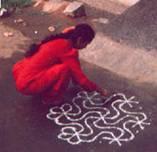
The Holi design
I had seen Bangalore in 1971 when it was still very British: clean roads winding around big green parks, numerous well-looked-after gardens, colonial style hotels, and neat shops. The term “Silicon Valley” was not yet known then. But the Government had already located here key defence, telecommunications and engineering industry. It was still a very attractive city. A number of Punjabis from Kenya have made it their home. Harmandir is a senior engineer in MICO, the Bosch of India. I had first met him in Geneva in 1983 after his technical/business trip to Bosch in Germany.
Bangalore is a sprawling city. I saw large estates with ultra modern buildings and houses mushrooming in all directions inviting national and multinational companies. I was in this city again in 1987. Environmentally, it has changed to the worse.
My aunt (Harmandir’s mother) was extremely happy to see me again. She told me of my childhood days. On Saturday (April 1), we walked in the city centre and drove through outskirts to see vast new construction zones. The spring festival of Hindu Holi is celebrated a few weeks later than in the north. Computer age and traditions go together. Early next morning I saw a lady making the sacred design in the entrance of her house.
A little later a few house down the road I was taken to young Ramandeep Singh, the local computer expert, to seek his help to obtain Urdu font. The way he treated his keyboard was impressive. Finally he was not able to meet my request. He was not yet twenty and had stopped going to the university. He believed in the power of information through computer network. He would soon start selling information and billions were waiting for him. So he aspired.
In the evening I invited the family to the 5-star Caesar’s Restaurant. Immaculately dressed waiters in black suit and bow tie served us a highly spiced dinner. It was a good change from eating at bus stops and in trains. But the next day my turbulent stomach made the first part of my eight-hour bus trip to the Nilgiri Hills quite uncomfortable.
During my bus trip to Mysore and Ooty (Udagamandalam) I ate nothing but fresh oranges, bananas and biscuits. Talking with a student nurse, Shani, made me disregard my discomfiture, until she disembarked at a small hill village near Ooty. Bus had been climbing steeply. Hilly-forested landscape drew my attention. Looking for wild game all I saw were occasional monkeys and a lot birds. When I arrived in Ooty (2,240m above sea level) at 4 p.m. it was already beginning to get chilly. Rolling green hills, lakes, forests and tea plantation reminded the British of southern England. So they made Ooty the summer headquarters of Madras government more than a hundred years ago. Remnants of those days can still be seen in hillside bungalows, cottages, tearooms, gardens, and churches. Once paradisiacal Ooty has now become filthy.
I was booked in Karnataka Tourist Guest House on Fern Hill about four kilometres from the town centre. The three-wheeler that had brought me to the guesthouse took me back to town. I explored the town. And booked a tall Tamil guide for trekking the next day.
At nine o’clock we took a crowded local bus to a Toda tribal village.

A typical Toda house
The Todas consider themselves to be direct descendants of Pandavas of the Mahabharta. They are the caretakers of soil and cultivating land is against their culture. They worship the buffalo. While men take care of buffalo herds, women embroider shawls. They still maintain igloo-type wooden houses, now mainly for tourists.
By invitation, I crawled into one of the huts on my knees and the old lady made coffee for us on an open hearth in thick buffalo milk I could imagine how exciting an experience it would be for many western tourists. In my village, where I had been three weeks earlier, as in every village in India, meals are cooked in that way.
It was the hut that interested me; a similar hut nearby served as a place of buffalo worship.

A Toda lady
I am surprised that women are not allowed to go in; they must stand out side at a certain distance, while men pray for them.
Then my guide announced that he was going to bathe at the village watering point and showed me the track to the Pykhara River Dam and Reservoir. On the way I saw a truck collecting dry cattle dung. Across the blue reservoir a herd of wild buffaloes waddled in mud and water. The water level was low. The blue lake beautifully adorned the forested shores. In order to safeguard the reservoir from pollution, human activity in the area seemed restricted. The boating club near the dam must be quite busy during the high tourist season. A lonely woman was gathering dry eucalyptus leaves, which she sells to the local oil mill to supplement the family income.
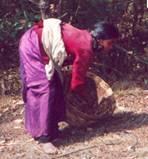
Leave gathering
For two hours I walked along the reservoir and then through the mainly eucalyptus forest. I expected to see the gaur, sambar, flying squirrel, langur, antelope and elephant. For that I should have spared more time and gone to Mukurthi National Park which is only a few kilometres further upstream towards Nilgiri and Mukurthi peaks (2556m).
Back in the village I was introduced to Asha, a very pretty well dressed girl of eighteen. She spoke Hindi and English. Recently she had had a successful “hole-in-the-heart” operation funded by some external benevolent person. She intends to continue her studies. During the return bus journey, the guide told me that he had inherited 140 000 Swiss Francs from an elderly European friend; but the Swiss concerned bank would not except his documents!
I reached Ooty at 5.00 p.m. I visited the Botanical Gardens, which are maintained quite well, a paradise for a botanist. Having enjoyed eating a burger at the popular Hot Bread, I phoned Geneva, the second time during the entire trip.
I could not conveniently travel, as intended, to Goa through the port of Mangalore along the West Coast. Making a mental note that I should return to that region one day I retraced the route back to Bangalore by bus the next day. That evening I told my cousin, “I’m sure there is a good simple fish and chips place in Bangalore. I do not feel like eating spiced Indian meal for a few days”. He was alone; the family had taken the train to the Punjab that morning. He took me to Koshys Parade Café on St. Mark’s Street, A popular restaurant still run in the British way. He said that he used to frequent it when he was not married. For four hundred rupees, we ate excellent fish and chips, followed by butter chicken chased down with beer. Probably the most satisfying meal I had in India.
—————————
